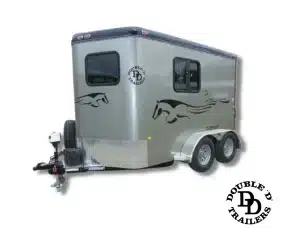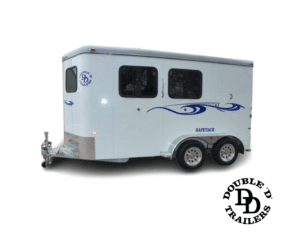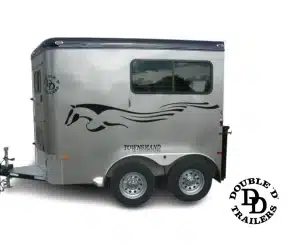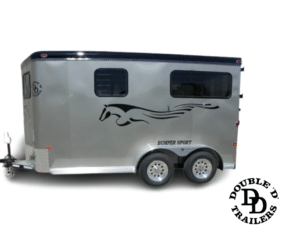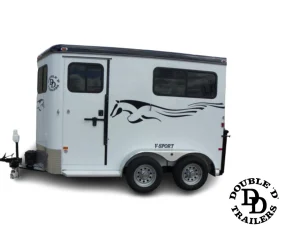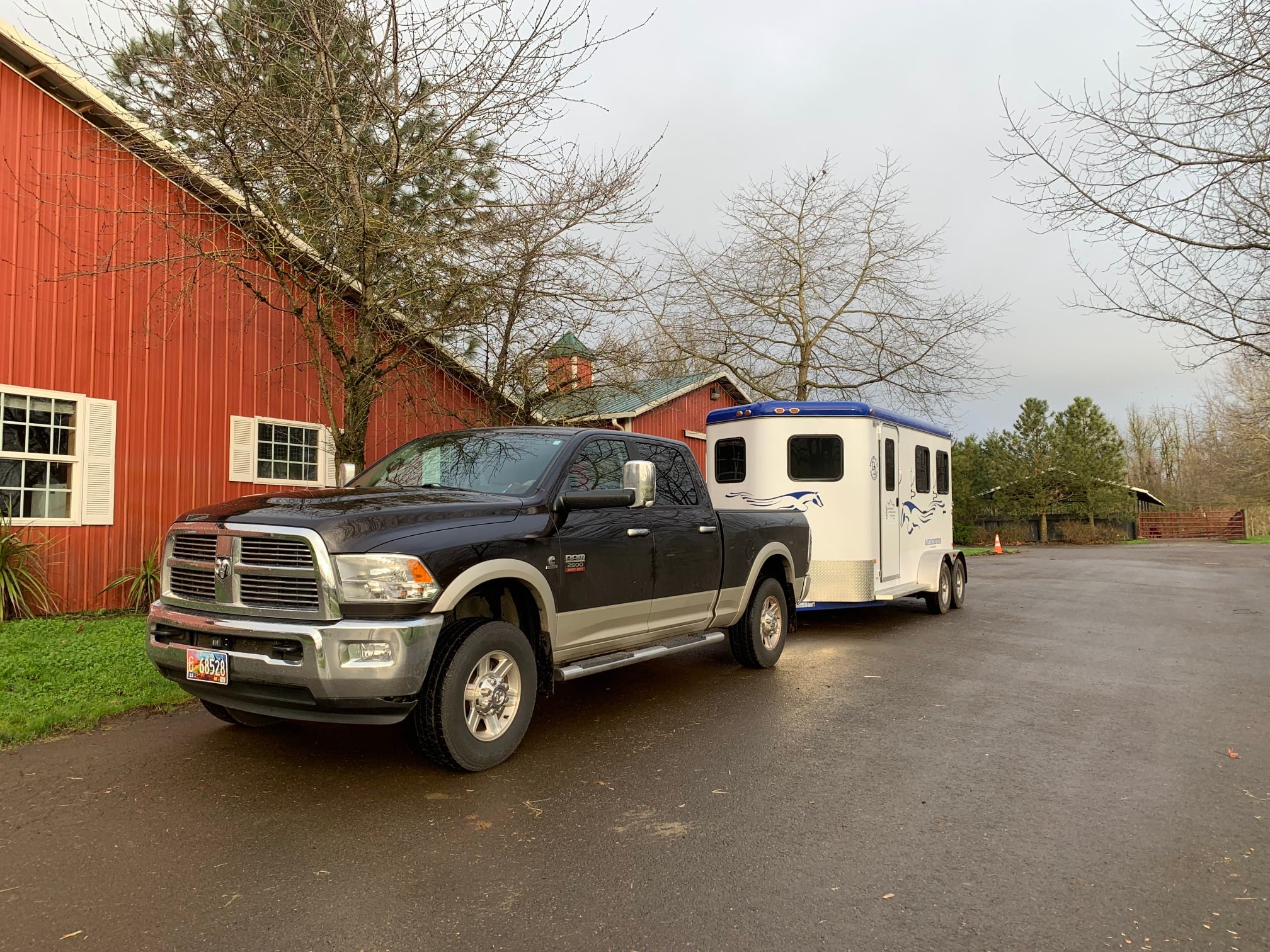6 Most Popular Bumper Pull Horse Trailers: Best and Worst
There are 6 types of bumper pull horse trailers, based on their popularity: 1-horse, 2-horse, 3-horse, and 4-horse models, alongside bumper pull horse trailers with living quarters and aluminum bumper pull horse trailers. Supply and demand outline their popularity: they’re searched for the most by potential clients and also most frequently listed on specialized horse trailer websites. Safety, price/value, longevity, and features also determine the popularity of these 6 bumper pull horse trailer types.
But how to determine which one is the best for you? Such a variety can be overwhelming to research and compare. Using thorough analysis and expert insights, we’ll pinpoint the individual pros and cons of each type. You’ll learn how to recognize the safest bumper pull horse trailer that provides the best price/value ratio while responding to all your needs.
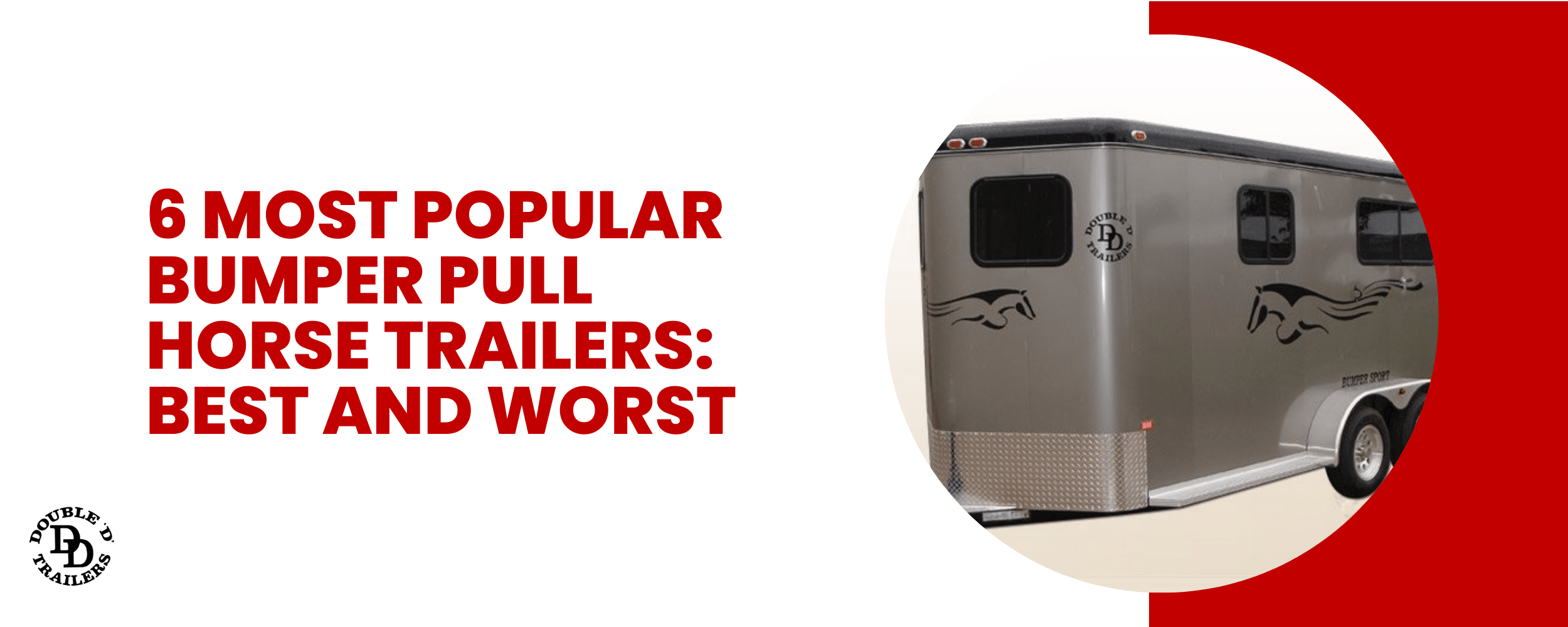
Top Factors to Consider When Choosing the Best Bumper Pull Horse Trailer
Clients often choose bumper pull horse trailers because they are easy to tow and maneuver, more affordable than other trailer types (in most cases), and cheaper to maintain and run. Plus, they can still accommodate up to 4 horses comfortably and be towed with (almost) any vehicle. In this section, we’ll save you valuable time by outlining the important criteria you can use to pick the ultimate bumper pull horse trailer.
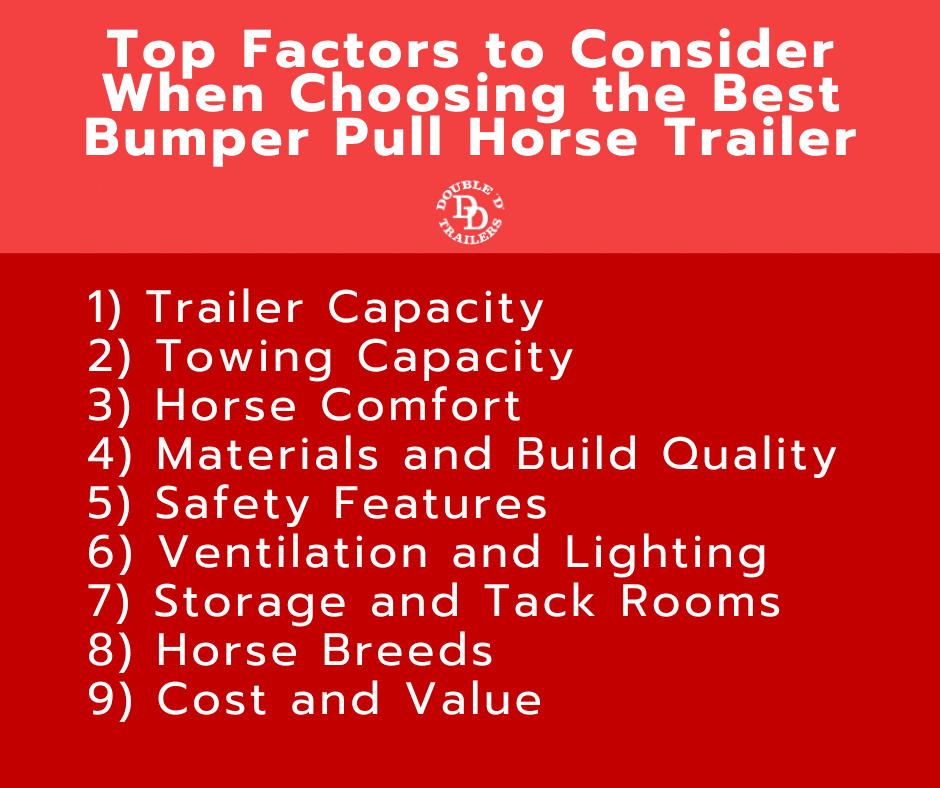
Trailer Capacity
Bumper pull horse trailers generally have less room for additional features such as living quarters, but they always offer sufficient space for horses. The perfect trailer for your needs should be capable of hauling the number and size of horses you own (or plan to own in the years ahead) comfortably and safely. The majority of bumper pull rigs can accommodate between one and four horses, which is why 1-horse, 2-horse, 3-horse, and 4-horse models are among the most popular types.
Towing Capacity
Knowing the towing capacity of your vehicle and the carrying capacity of the trailer is not enough: you should be aware of the limits and requirements applicable to both of them. It’s best to start by understanding tongue weight.
Even if your vehicle’s towing capacity is enough to handle the fully loaded bumper pull horse trailer you have or intend to purchase, the vehicle might not cope with the trailer’s tongue weight, which is typically 10 to 15% of the trailer’s total weight. You should calculate tongue weight and thus eliminate the chance of overloading your tow vehicle.
Don’t forget that the gross vehicle weight (GVW) of the combination of vehicles you plan to use (tow vehicle plus horse trailer, both fully loaded) must be compliant with all applicable laws, rules, and regulations. The tow vehicle must be adequate to the trailer’s weight and dimensions, as it affects numerous safety aspects, such as handling, weight distribution, braking power, tires, and more.
Horse Comfort
Horse comfort is a primary purpose of utilizing a bumper pull horse trailer. To achieve an ample level of horse comfort, a trailer should cover several aspects, as follows:
- Stall space: Horses need to have enough space inside the stall to move their heads freely and not feel confined. The stall dividers should be sturdy and designed to prevent injuries while not blocking horses’ sight completely.
- Ventilation: Proper ventilation is equally important for health and comfort reasons. It’s usually provided by roof-mounted vents or sliding windows with screens that allow extra airflow.
- Insulation: The roof and wall insulation of a horse trailer add to horses’ comfort by reducing outside noise and vibration while moving. Proper insulation also reduces the temperature inside the horse area.
Materials and Build Quality
A bumper pull horse trailer should be constructed using advanced fabrication and assembly processes and state-of-the-art materials to ensure several important factors, as follows:
- Durability: Long-lasting, rigid materials such as composites and modern fabrication processes ensure a bumper pull horse trailer’s durability by allowing it to cope better with harsh weather and intense exploitation. For example, replacing welds and rivet joints with modern bonding systems brings structural stability and reduces wear and tear, literally speaking.
- Longevity: All the above results in better longevity as well. Choosing the right materials and not allowing build quality compromises results in a longer lifespan: thanks to innovations such as the Z-Frame material, trailers are not prone to rusting and handle extensive use with greater ease thanks to the superior strength of components made from it.
- Horse safety: This is the top priority of horse trailer makers such as Double D Trailers, and it’s a goal mostly achieved through implementing the latest advancements in materials, building methods, and design. Using composites allows for light, yet strong safety solutions such as the SafeKick wall system and the SafeBump roof system.
Safety Features
Numerous safety features define a quality bumper pull horse trailer, all of which are critical for the safety and well-being of your horses. Horse trailer safety incorporates numerous components based in their purpose, as follows:
- Trailering: For the ultimate safety of both horses and humans are safe, a bumper pull horse trailer should have a solid upright structure that provides protection in case of accidents. A quality trailer should also have a low center of gravity to ensure proper handling and performance while on the road, which is doable thanks to features such as composite roofs, Z-Frame stall dividers, and so forth.
- Loading: A bumper pull horse trailer should boast non-slip ramps and flooring to provide enough grip for horses and thus prevent injuries. The ramps and individual stalls must be wide and approachable enough for the same reasons.
- Hitching: The trailer coupling mechanism must be in perfect working order to guarantee safety. This comes alongside a couple of other necessities: safety chains and an electric breakaway system.
Ventilation and Lighting
Proper ventilation and lighting provide the conditions needed for horses to feel calm inside the trailer when parked or while on the road. They don’t like confined and dark spaces, and such conditions may result in health issues such as respiratory or gastrointestinal problems. Therefore, ventilation solutions such as roof vents and sliding windows with built-in screens are must-haves. The latter also provides more natural light inside the horse area. Sufficient exterior and interior lighting bring extra safety during loading or unloading by illuminating every corner of the horse area and the surroundings of the loading ramps.
Storage and Tack Rooms
Bumper pull horse trailers usually have restricted storage space to offer, meaning that they require specific solutions. The SafeTack design patented by Double D Trailers is a great solution: It’s a swing-out tack compartment placed in the back of the trailer, allowing for easy loading or unloading. Overall, it’s important to keep all tack and gear separated from the horse area for safety reasons, not to mention that even a tiny storage space equipped with wall grid organizers and other options can help you carry a lot of things arranged neatly.
For other supplies such as hay bales, you can choose between several solutions such as roof-mounted racks which save plenty of precious space inside the horse area.
Horse Breeds
The breed and number of your horses are key factors when choosing the right bumper pull horse trailer type and model. It should be a perfect fit: not too big, but not too small, either. Trailers that can barely fit your horses will make them feel claustrophobic, which can affect their behavior and health in a negative way. If the horse area is too big, horses can move around too much, causing a weight distribution imbalance and allowing room for injuries. For example, bumper pull horse trailers built by Double D Trailers can accommodate horses between 15 and 17 hands comfortably and safely. Not only that, but you can specify the trailer dimensions when you order it, meaning that it will be a tailor-made solution for your horses.
Cost and Value
When choosing your new bumper pull horse trailer, you don’t necessarily need to opt for the most expensive one of them all, hoping that it will be a “full options” model that will respond to all your needs. Chances are, it will not be what you hoped for initially. Cost and value are two different things. When you have a specific budget for purchasing your next bumper pull horse trailer, you can maximize the value you will get for the price you pay. To do that, you should compare your priorities and align them with the current market. This way, you will know if your budget is sufficient to cover the trailer of your dreams. Typically, the best-case scenario is to order a custom-built rig. This would allow you to specify the dimensions, materials, and every other aspect of the trailer, and you could only add the features and perks you really need. This way, you won’t have to pay extra for equipment you don’t need, as it happens quite often when purchasing a model available in stock.
Popular Bumper Pull Horse Trailers in the Market: A Comparative Guide to Safety and Value
1-horse, 2-horse, 3-horse, and 4-horse bumper pull horse trailers, living quarters bumper pull horse trailers, and aluminum bumper pull horse trailers are the most popular types when you consider specific aspects, as follows:
- Most frequently searched bumper pull horse trailer types
- Most often listed on specialized websites and classifieds
- Most frequently offered in showrooms and dealerships
In this section, we’ll take a closer look at each type and pinpoint their primary advantages, alongside the reasons to consider either of them. By comparing the most popular bumper pull horse trailer types, we’ll cut to the chase and save you many hours of thorough research. You’ll learn which type would work best for you, so you won’t end up purchasing a useless horse trailer or ordering one that’s way over the top. Knowing how to make a good investment when in the market for such a vehicle is key.
1-Horse Bumper Pull Trailer
1-horse bumper pull trailer trailers are the smallest in size of them all. They’re meant to provide accommodation for a single horse. Some manufacturers such as Double D Trailers offer 1-horse bumper pull living quarters trailers, which is an ideal solution for individuals who own just one horse and need means of transportation for longer distances.
Pros
- Low price: This bumper pull horse trailer type is usually very cost-effective because it provides specialized means of transport at an affordable price.
- Enhanced maneuverability: 1-horse bumper pull trailers are easy to tow and maneuver, not to mention that they can be towed by most vehicles.
- Easy maintenance: Such trailers are simple and cheap to service and maintain. They’re also easier to store due to their comparably small size.
Cons
- Limited capacity: Many 1-horse bumper pull trailers don’t have sufficient space for storage, tack or dressing room, or living quarters.
- Potential limitations for larger breeds: Not all 1-horse bumper pull trailers can accommodate larger horse breeds, but some models can be ordered with custom dimensions to create a tailor-made result.
Expert's Insights
Truth is, the best recommendation is never universal. It depends on the specific needs of every customer. An individual who needs to haul only one horse should definitely opt for a 1-horse bumper pull trailer, as there’s no reason to go for a bigger one. This will keep costs low, not to mention that the larger a bumper trailer is, the harder it is to tow. The best bumper pull horse trailer is a choice that depends on horse size and breed, tow vehicle, accommodation requirements, and other considerations, based on which we make individual assessments and recommendations.
2-Horse Bumper Pull Horse Trailer
2-horse bumper pull trailers usually receive the most attention due to the better variety of additional options and layouts. They come in several configurations: straight or slant load, with options for reverse or forward-facing horse area design, depending on the model.
 Pros
Pros
- Compact size: While typically bigger than 1-horse trailers, 2-horse models are still compact enough to be towed conveniently and safely by first-time horse trailer owners.
- Affordability: Compared to 2-horse gooseneck trailers, for example, a 2-horse bumper pull trailer would still be significantly cheaper in the majority of cases.
- Better variety of options: 2-horse trailers often come with more possible options thanks to their larger interior space, thus allowing for a perfect fit to your needs.
Cons
- Higher tongue weight: 2-horse bumper pull trailers can weigh a lot, especially when they feature living quarters and other options, which adds to their tongue weight as well.
- Potential suitability issues for larger breeds: If a 2-horse bumper pull model can’t be ordered with customized dimensions, it might not be a good fit for larger horse breeds.
Expert's Insights
2-horse bumper pull horse trailers are among Double D Trailers’ bestsellers. Approximately 70% of them are built in a reverse load configuration. Many clients choose the 2-horse model even when they currently own just one horse, as they have the option to purchase another and not have to change their trailer because of that. When it comes to recommendation factors, the same as the 1-horse bumper pull applies: the best advice is always based on individual criteria.
3-Horse Bumper Pull Horse Trailer
3-horse bumper pull trailers are obviously bigger and capable of handling more load than 1-horse and 2-horse models, but the larger size comes with several negative aspects you should consider before making a decision.
 Pros
Pros
- Increased capacity: The biggest advantage of 3-horse bumper pull trailers is their enviable capacity. They offer a safe and comfortable stall area for three horses, and there’s space left for tack and gear rooms.
- Versatility: You can haul just two horses in a 3-horse bumper pull trailer, but you can’t fit three horses in a 2-horse model, which brings versatility to a new level if you choose the former type instead of the latter.
- Plenty of configurations and options: 3-horse bumper pull trailers come in all possible loading and standing configurations, meaning that you can have a custom, tailor-made trailer that meets every last requirement you might have.
Cons
- Weight distribution concerns: If you don’t use the full loading capacity of such a trailer and only haul two horses instead of three, you may experience issues related to flawed weight distribution. Overall, 3-horse bumper pull trailers are notably heavier than the previous two types we discussed, meaning they are harder and trickier to tow.
- Axle placement variability: Not all 3-horse bumper pull trailers are the same when it comes to design, including axle placement. This means that the trailer’s tongue weight can vary depending on the loading style, and that can cause issues when towing as well.
- Possible swaying: Due to the reasons mentioned above and other potential causes, 3-horse bumper pull trailers are more prone to sway when loaded incorrectly, as reported by some clients.
- Pricing: Some 3-horse bumper pull trailers’ prices are significantly higher than 1-horse and 2-horse models, and they can sometimes be near the price of a gooseneck trailer with a similarly spacious horse area.
- Maintenance and durability challenges: The larger size of 3-horse bumper pull trailers and their typical equipment equal harder and more expensive maintenance. Harsh weather could also result in additional care and repairs.
Expert's Insights
One of the key factors for a successful 3-horse bumper pull trailer is having a tow vehicle strong enough to pull it. The majority of SUVs would struggle with towing a 3-horse bumper pull trailer, and the same goes for half-ton pickup trucks. The higher trailer payload typical of this configuration is sometimes the reason clients are advised to switch to a gooseneck model, especially when living quarters are involved. Still, designing a 3-horse bumper pull model is sometimes a must. For instance, Double D Trailers has built such trailers for clients who want to pull them behind an RV. This requires extended changes to the trailer design for it to be a perfect fit to the client’s particular RV in terms of maneuverability, turning and ground clearance, and so forth. In such special cases, a 3-horse bumper pull trailer would be a working solution.
4-Horse Bumper Pull Horse Trailer
If you own multiple horses and you intend to visit multiple equestrian events per year, you should consider getting a 4-horse trailer. While there are 4-horse bumper pull models available today, such a configuration works best as a gooseneck trailer. 4-horse bumper pull trailers with living quarters, for example, are extremely long and quite heavy, therefore, harder to maneuver and tow.
 Pros
Pros
- Spacious interiors: 4-horse bumper pull trailers offer plenty of room inside, and have sufficient additional space for tack, gear, and living quarters.
- Fit for professional use: Professional equestrians may find 4-horse bumper pull models to be a good solution for transporting four horses at once and having sleeping and dining areas on board.
Cons
- Weight distribution concerns: Similarly to the 3-horse bumper pull trailers, 4-horse models can suffer from issues caused by bad weight distribution and loading patterns. The sheer size and capacity of this trailer type make it harder to put most of the weight over the axles. As a result, these trailers are typically hard to tow and maneuver.
- Insulation issues: Some 4-horse bumper pull trailers’ insulation may not be sufficient to maintain a comfortable temperature in the horse area due to its size. This mostly depends on the trailer model and it could cause plenty of problems in the scorching heat.
- Ventilation: In large trailers such as the 4-horse bumper pull type, proper ventilation may be an issue. This feature is vital for the health and behavior of the horses inside, and its absence can lead to problems in hot areas.
- Loading and unloading difficulties: Depending on the trailer model and layout, it could be difficult to load or unload all horses. Not all 4-horse bumper pull trailers offer wide enough doors and ramps, not to mention that access to the first horse is most often restricted or impossible.
- Size and maneuverability issues: 4-horse bumper pull trailers’ size and hitch type make going through narrow road sections and corners or tight spaces either extremely difficult or even impossible.
- Braking: Considering how much a fully loaded 4-horse bumper trailer weighs, it might be difficult to stop one attached to your pick-up or SUV, especially if the trailer is an older model equipped with an outdated braking system.
- Price tag: It makes sense that 4-horse bumper pull trailers cost a lot, but many of these trailers are expensive enough to make you sit back and assess all related costs: maintenance, servicing and consumables, insurance, and so forth. You need to be careful not to go over your budget.
Expert's Insights
4-horse bumper trailers are typically large in size and tongue-heavy, meaning that they would require specific vehicles to pull them, such as ¾ ton trucks that can handle the tongue weight. This is why clients most often opt for goosenecks when they need to haul 4 horses inside a single trailer.
Bumper Pull Horse Trailer with Living Quarters
Bumper pull horse trailers with living quarters come in a variety of sizes: the most popular models can carry between one and four horses. However, such trailers designed to accommodate more than two horses can be too tongue-heavy, not to mention their significant weight and size. Uneven weight distribution and inability to evenly spread the load over the axles cause bad maneuverability and poor tow vehicle steering, thus leading to safety risks. If you need a living quarters trailer to carry two or more horses, your best bet would almost always be a gooseneck alternative. Still, 1-horse bumper pull horse trailers with living quarters are a smart choice thanks to their appropriate layout and acceptable weight and size.
> TOUR THE DOUBLE D TRAILERS 1 HORSE BUMPER PULL WITH LIVING QUARTERS MODEL
Pros
- Comfort and convenience: When you’re parked for a few days during an event, having a place where you can have a meal and get some sleep without having to pay for accommodation and search for restaurants is a huge advantage.
- Practicality: 1-horse bumper pull trailers with living quarters could be towed by your everyday SUV. Also, this type of trailer is easy to maneuver and store on your property, not to mention that it offers decent accommodation for both you and your horse.
- Cost: Bumper pull horse trailers with living quarters are almost always easier to purchase and maintain when compared to goosenecks with similar features.
Cons
- Negative tongue weight risk: Living quarters bumper pull trailers for 2 or more horses often have their axles positioned too close to the front of the trailer, which may result in negative tongue weight. This reduces road stability and may cause accidents.
- Weight imbalance: When fully loaded, a large bumper pull trailer with living quarters for two or more horses could end up having improper weight distribution. Negative tongue weight is one of the possible issues caused by this, and too much vertical tongue weight is another possible negative result you should be aware of. Having too much weight in the back will most likely cause the trailer to sway, which can lead to major accidents. Overloading the front of the trailer can be equally bad for road safety and ease of towing.
- Higher costs: The purchase price and all the following costs related to owning and maintaining a bumper pull horse trailer with living quarters are significantly higher compared to a model without such a feature. All the additional equipment this trailer type boasts adds to both weight and price.
- Increased maintenance: Living quarters add a lot of comfort and practicality, but these perks come with the need for extensive maintenance and additional attributes such as water tanks, for example.
- Towing concerns: Not all SUVs can pull bumper pull horse trailers for 3 or 4 horses due to their weight, meaning that your existing vehicle may not be suitable for this job. In today’s market, there’s hardly a vehicle rated to haul 3-horse or 4-horse trailers. One of the reasons for that is the too short wheelbase of most SUVs, alongside their inability to handle such a payload.
- Possible overloading: A bumper pull horse trailer with living quarters is heavy even when not loaded, given all the extra features it has compared to a regular tag-along. When you add the weight of the horses, the tack, the supplies, and the rest of the gear you need, you begin to realize how easy it is to overload such a rig.
- Increased safety concerns: Some bumper pull trailers with living quarters have insufficient horse areas: they can be less spacious or comfortable for your horses, which can cause health and safety concerns.
Expert's Insights
Clients would often like to purchase a living quarters bumper pull trailer for two or more horses. The reason they insist on having such a configuration is practicality: they want to tow it using their daily driven SUVs or half-ton trucks. This is where the major problem lies – most such vehicles are incapable of pulling living quarters horse trailers for two or more horses. However, some trailer makers try to respond to the needs of such buyers and design models with axles mounted further than usual in an attempt to reduce tongue weight. As a result, the so-called “seesaw” effect can be observed: when there’s only a single horse in the back of the trailer, the result is negative tongue weight. Dually pickup trucks could pull 2-horse, 3-horse, or even 4-horse bumper pull horse trailers, depending on the truck model and capabilities, but if you have such a truck, it would be best to opt for a gooseneck model instead. Double D Trailers doesn’t manufacture bumper pull trailers with living quarters that accommodate two or more horses due to safety concerns. The only living quarters bumper pull rig available is the 1-horse model. Its design makes achieving a negative tongue weight impossible thanks to adequate axle placement.
Aluminum Bumper Pull Horse Trailer
Aluminum bumper pull horse trailers are generally lighter than steel models and don’t rust, but they’re more expensive. Due to the comparably lighter structure, these trailers are typically capable of higher payloads. Still, they are prone to corrosion, not to mention that some models have aluminum side walls and floors that bend easily. There are all-aluminum horse trailers on the market, but many models feature an aluminum upright structure mounted on a steel frame.
 Pros
Pros
- Lightweight design: Aluminum is lighter than steel, but it’s still durable, which makes it a suitable material for vehicle manufacturing.
- Corrosion resistance: As stated earlier, aluminum doesn’t rust, which extends the material’s life.
- Durability: Aluminum bumper pull horse trailers have the potential to last for a long time when properly cared for. Even regular cleaning is essential for such a trailer’s lifespan.
Cons
- Thin walls: Some aluminum horse trailer models have much thinner exterior walls than needed, which compromises safety and comfort. Sometimes, a horse kick is enough to pierce through such walls.
- Welds and rivet joint issues: Since aluminum is weaker than steel and could tear instead of flex when exposed to stress, welds and rivet joints can be compromised.
- Corrosion on aluminum floors: Aluminum horse trailer floors are prone to corrosion because they’re constantly exposed to contaminants such as horse urine. Therefore, regular cleaning is a must.
- Heat conduction: Aluminum is known to be a great heat conductor, meaning that the interior of a horse trailer can get extremely hot, thus causing discomfort to your horses, not to mention the potential health issues. For example, aluminum roofs can bring the temperature inside the horse area to unbearable levels. The best alternative solution is a composite, seamless roof structure such as the SafeBump solution: it’s light, strong, prevents leakages, and doesn’t conduct heat.
- Expensive repairs: If aluminum side walls, flooring, or exterior panels suffer damage, they would be expensive to replace or repair.
- High purchase price: As already noted, aluminum trailers are significantly more expensive than comparable steel models. On the upside, their resale value is typically higher as well.
- Strength concerns: Aluminum is not as strong as steel, meaning that aluminum horse trailers can’t handle extremely heavy loads.
Expert's Insights
Aluminum can bend easily, and it can only be strong enough when it’s thicker, which causes the material to become brittle. This causes a whole new problem: brittle aluminum can be very dangerous in case of a road accident. Additionally, aluminum is known to be a great heat conductor, which is a downside when it comes to building horse trailers. An aluminum roof would attract and retain heat, which is the opposite effect compared to a composite roof’s insulation qualities. Aluminum floors also oxidize when exposed to the elements and different contaminants such as horse urine. Some clients prefer aluminum trailers because they think that they will avoid rust issues typical of steel, but the oxidation of aluminum causes similar problems. The key is proper maintenance and regular thorough cleaning.
The Best Bumper Pull Horse Trailers: Time-Tested Recommendations
Thanks to over 25 years of experience in crafting horse trailers and bringing groundbreaking innovations to this industry, Double D Trailers’ designer and owner Brad Heath has tons of expert advice and suggestions to share. In this section, he’ll showcase the most requested bumper pull horse trailer models, alongside their configurations, layouts, and features, thus providing you with a professional outlook on the world of bumper pull horse trailers.
Clients request rear saddle compartments, and they have demanded them quite often over the years. Since it was an unsafe design that caused accidents, Brad came up with the SafeTack solution that was patented: a swing-out tack compartment that’s now the only option for Double D Trailers when it comes to tack storage in the back of any model.
Sometimes, clients have asked for specific horse area dividers that could also serve the purpose of hauling other animals, such as cattle or goats. Creating an effective solution that is also perfectly safe for hauling horses and other animals is not possible, therefore, Double D Trailers allows for safe horse dividers as the only possible option.
- SafeTack 1 horse slant load bumper pull trailer
- Can fit up to 17 hand horse
- Custom dressing room
- SafeTack 2 horse slant load bumper pull trailer
- Customizable stall sizes to accommodate each horse
- Lightweight; can be towed by most SUVs
- SafeTack 3 horse slant load bumper pull trailer
- Can also be built for 4 horses
- Easy towing due to short wheelbase and lighter tongue weight
- Townsmand 2 horse straight load bumper pull trailer
- Small and lightweight
- Half-height tack storage under horse manger
- Bumper Sport 2 horse straight load bumper pull trailer
- Side ramp add-on available
- Classic 2 horse bumper pull model; ideal for 2 horses - dressing room included
- V-Sport 2 horse straight load bumper pull trailer
- Spacious walk-in tack room in the front
- Z-Frame dividers provide more air flow to your horses
- SafeTack 1 horse bumper pull trailer with living quarters
- Foldable table transforms into bed; full shower can be added
- Can be towed with full sized SUVs
5-Step Guide to Choosing the Right Bumper Pull Horse Trailer
- Assess Your Equine Needs
Choosing the right bumper pull horse trailer starts with the consideration of your equine needs. You need to take several factors into account: the size, breed, number, and behavior of your horses. While tools such as the horse trailer finder are suitable, you should plan ahead and invest in a trailer that would be the ideal solution for you for years to come.
- Set a Budget
Having a realistic and strict budget will help you avoid overspending and buying a trailer you don’t really need. Quite the opposite: it will help you narrow your search and only focus on a handful of possible options that are affordable and potentially suitable for you and your horses.
- Research Brands
Before you make a final decision, you need to compare the most reputable brands that offer the kind of bumper pull horse trailers you need. Checking for feedback such as comparison tests and user reviews online is a must to confirm the good reputation and quality of each brand. For instance, Double D Trailers have hundreds of Facebook and Google reviews, not to mention the substantial amount of information you can find on their official website.
- Inspect the Trailer
Regardless if you’re buying a brand-new, custom-built bumper pull horse trailer or a used one, you should inspect it thoroughly before buying it. Some dealers only chase their best interest, and that may result in a deal you don’t want to be a part of. If you have the chance, it’s best to load your horse to make sure there’s enough room and to assess if there are any loading or unloading issues. During the inspection, check all aspects: build quality, technical condition, materials, features, and options such as lighting, ventilation, insulation, and so forth. Every small detail counts.
- Seal the Deal
Signing the order for your new trailer or the purchase contract needs to come alongside certain manufacturer or dealer obligations such as delivery and warranty terms. For example, Double D Trailers' Warranty Program comprises several coverages, including a 2-year bumper-to-bumper warranty. This comes alongside a nationwide flat delivery fee of $395.
Order the Safest and Best-for-Value Bumper Pull Horse Trailer Among Popular Options
The variety of bumper pull horse trailer designs, sizes, and layouts may initially seem overwhelming. You can choose between 1-horse, 2-horse, 3-horse, and 4-horse models, bumper pull horse trailers with living quarters, and aluminum bumper pull horse trailers (or a combination of some of them, such as an aluminum 1-horse bumper pull trailer with living quarters, for example). This guide should give you the strong knowledge foundation you need to make an informed decision. The tips and expert advice we shared can help you prioritize all the important factors when doing your research and choosing the right bumper pull trailer type.
When you narrow down your search for the ultimate bumper pull horse trailer using all the suggestions above, don’t forget to compare their advantages and drawbacks. In today’s market, you won’t be forced to make a compromise if you’ve set a realistic budget. Your dream bumper pull horse trailer is closer to you than ever.

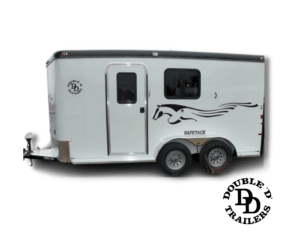
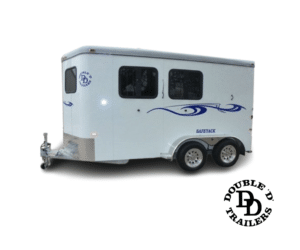 Pros
Pros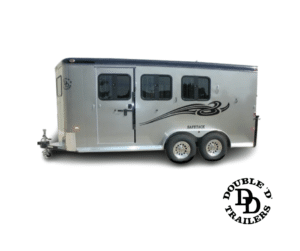 Pros
Pros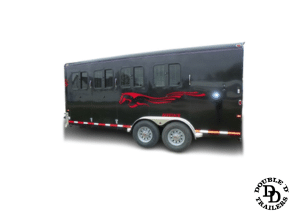 Pros
Pros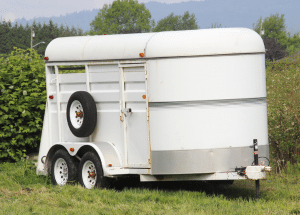 Pros
Pros